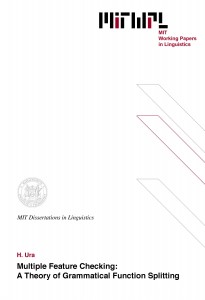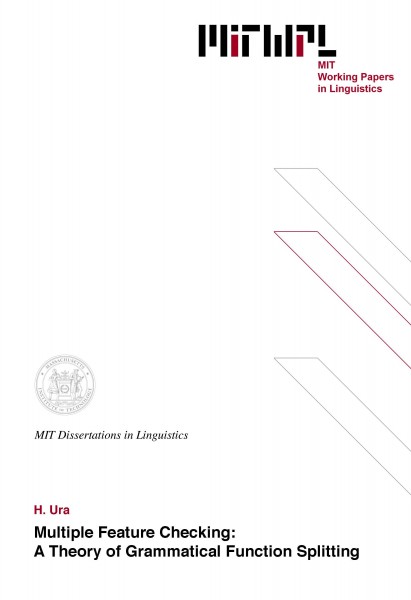Multiple Feature Checking: A Theory of Grammatical Function Splitting
H. Ura, 1996
This thesis investigates some consequences of the theory of formal feature-checking in the minimalist program for linguist theory (Chomsky 1992, 1994a, 1995b). More specifically, I will explore the significance and implications of the theory of multiple feature-checking. The main purpose of this thesis is to demonstrate that the theory of multiple feature-checking enables us to give a natural and consistent explanation of some less-familiar phenomena in the literature under the generative tradition, phenomena in which some of the grammatical functions alleged to be associated with a certain grammatical relations are split up from them into some others (Grammatical Function Splitting).
Part I offers a brief sketch on the previous studies on “grammatical relation” and “grammatical function” (Chapter 1) and a concise introduction of the fundamentals of the theory of multiple feature-checking together with the other minimalist notions/techniques particularly prerequisite to the discussions that follow in this thesis (Chapter 2).
In Part II (Chapter 3 and 4), it is shown that some raising constructions, which have been scarcely studied in the literature under the Principle-and-Parameters approach, can be offered a consistent account by the theory of multiple feature-checking.
Part III (Chapter 5 and 6) argues that the theory of multiple feature-checking provides a clue for elucidating the optionality of movment, which is sometimes alleged to be seriously problematic under the theory of economy and movement in the minimalist program of Chomsky (1992, 1994a).
Part IV (Chapter 7, 8, 9, and 10) deals directly with phenomena involving grammatical function splitting. There it is demonstrated that these varieties of grammatical function splitting can be given a natural and consistent explanation with the aid of the theory of multiple feature-checking.
Concluding remarks together with a comment on the further applications of the theory of multiple feature-checking will come in Chapter 11.
Thesis supervisor: Noam Chomsky
Title: Institute Professor
Table of Contents
Part I Conceptual/theoretical backgrounds 17
Chapter 1 Grammatical functions and grammatical relations 19
0 Introduction
1 Approaches to grammatical function splitting
2 GF splitting under the PP-approach
3 A minimalist approach to GF splitting
4 The organization of the present thesis
Chapter 2 Multiple feature-checking and minimalist assumptions 29
0 Introduction
1 Outline of the minimalist theory
1 Conceptual backgrounds
2 Derivational model for structure building
3 Formal features and their checking
4 Agr-less feature-checking theory
5 Economy of operations and the theory of attract
2 The theory of multiple feature-checking
1 Multiple specs and violability of procrastinate
2 Multiple feature-checking and parameter-setting
3 Theoretical basis on violability of procrastinate
3 Overview of major proposals
1 Strength of features and merge-attract interaction
2 Syntactic mapping of argument structure
3 Equidistance, multiple specs, and overpassing
4 Optionality
1 Surface optionality of raising and violability of procrastinate
2 Optional attraction before SPELL-OUT and
equidistance
3 Derivational/local economy
5 Feature-checking as a syntactic operation
6 Grammatical functions and [+/-construable]-features
7 The impersonal parameter
Appendix On the nature of strong FFs
Part II Raising and multiple feature-checking 67
Chapter 3 Long distance raising 69
0 Introduction
1 Copy-raising
1 Basic facts
2 Issues
3 Checking as an operation
4 Analysis
5 Resumptive pronouns
2 Superraising
1 Facts
2 New analysis of superraising
3 Examination of possible derivations
4 Ura’s (1994a) problems and their solutions
3 Summary
Appendix An alternative account of copy-raising and hyper-raising
Chapter 4 (In)alienable possessive construction and possessor-raising 79
0 Introduction
1 Basic properties of possessor-raising
1 Inalienable and alienable possessors
2 Subject/object asymmetry of possessor-raising
2 Internal structure of (in)alienable possessive DP
1 Inalienable possessive DP
2 Alienable possessive DP
3 Discussion
1 Syntactic/morphophonological distinction between
alienable and inalienable possessives
2 Combination of D(Poss) and inalienable noun
3 Two types of possessive genitives in English
3 How and why does possessor move?
1 How to raise possessor
2 Why is possessor raised?
3 Deriving the typological variety of possessor-raising
4 More on the difference between Japanese and Korean
4 Grammatical function splitting in PossRaising
5 Summary
Part III Optional Movement and Procrastinate 145
Chapter 5 Parameters for the double obkect construction 147
0 Introduction
1 Larsonian VP-shell in the Agr-based Case Theory
2 Underlying structure for DOC
3 Deriving typological/dialectical differences in DOC
1 Norwegian/Swedish vs. Danish
1 The parameter for multiple specs
2 Passivizability of DO in DOC
3 Parameter for Vmid in DOC
2 British vs. American English
3 Explanation of the crosslinguistic generalization
4 Summary
Appendix (A) Against the “extended” neo-Larsonion VP-shell
Appendix (B) Typological variety of DOC
Chapter 6 Overt object shift in Japanese 189
0 Introduction
1 Basic word order of Japanese ditransitive clauses
2 Object shift in ditransitive clauses
1 Object shift to an A-position
2 Wither is the object shifted?
1 Floating quantifiers and adverbials
2 Object shift of IO?
3 Object shift of DO
4 Feature-checking of double objects
1 Checking of IO
2 Checking of DO
3 Optionality of object shift and violability of procrastinate
1 Fukui (1993a) on optionality of movement/
scrambling
2 Optionality and modification of the last resort
condition
3 Proposal: violability of procrastinate
4 Passivizability of DO and violability of procrastinate
3 Object shift out of desiderative complement
1 Desiderative complement in Japanese
2 Violability of procrastinate
4 Object shift in transitive clauses
1 Impossibility of object shift in transitive clauses
2 Lexical differences in violability of procrastinate
5 Summary
Appendix Optional vs. obligatory object shift
Part IV Grammatical Function Splitting Phenomena 231
Chapter 7 Active/inverse voice alternation 233
0 Introduction
1 Bantu inverse voice
1 Basic properties of Bantu inverse system
2 Mechanism of active/inverse alternation in Bantu
1 Optionality of Banty inverse system
2 Grammatical function splitting in inverse voice
3 Why is SUBJ in a passive clause obligatoryily
demoted?
3 Lexical/syntactic restriction on active/inverse alternation
4 Deriving the parametric differences
5 Summary for Bantu inverse voice
2 Apachean inverse voice
1 Basic properties for Apachean inverse system
2 Mechansim of active/inverse voice alternation in Apachean
3 Animacy hierarchy and the deletion of Infl’s EPP-feature
4 Subjecthood of SUBJ in Navajo inverse voice
3 Summary
Appendix (A) English quotative inversion
Appendix (B) Inversion and derivational economy
Chapter 8 Anti-impersonal passives 277
0 Introduction
1 Anti-impersonal passive in Lango
1 Basic properties of “long object shift” in Lango
2 Wither does OBJ go by LOS?
1 Switch reference in Lango: evidence for OBJ in
Spec-IP
2 Surface position of SUBJ in Lango
3 Derivation of anti-impersonal passive in Lango
4 Grammatical function splitting by LOS
5 Summary of Lango anti-impersonal passive
2 Anti-impersonal passive in Imbabura Quechua
1 Basic properties of Imbabura Quechua passive
2 Grammatical function splitting
1 Subjecthood of the promoted OBJ in anti-impersonal
passive
2 Grammatical functions of SUBJ in anti-impersonal
passive
3 Explanation
4 Parametric variations
5 Summary for Imbabura Quechua anti-impersonal
passive
3 Explanation
4 Parametric variations
5 Summary for Imbabura Quechua anti-impersonal passive
3 Summary
Chapter 9 Dative subject constructions 319
0 Introduction
1 Japanese (and Korean)
1 Basic properties
1 Case arrays
2 Subjecthood of dative subject
3 Non-subject properties of nominative object
2 Proposal
3 Analysis
4 Explanation
1 Grammatical functions
2 Case arrays
3 Possessor-raising from nominative object
4 Potential suffix in Japanese
5 Supporting evidence
1 Scope of nominative object
2 Long-distance feature-movement
6 Summary and problems
2 Tamil (and other Dravidian)
1 Dat-acc pattern
2 Dat-nom pattern
3 Analysis
1 Proposal
2 Explanation
3 Grammatical functions
4 Evidence for the difference between dat-acc and dat-nom
5 Summary and dative subject in Kannada
3 Icelandic (and Germanic)
1 Data
2 Analysis
1 Proposal
2 Explanation
3 Subjecthood of dative (quirky) subjects
4 Licensing of nominative objects
3 Passive and dative subjects in Germanic
4 Experiencer inversion in Dutch
4 Theoretical implications of DSC
1 Inversion in Germanic and derivational (local) economy
2 Icelandic DSC vs. Bantu inverse
5 Summary
Appendix (A) Old English and historical change
Appendix (B) DSCs/QSCs in other languages
1 Russian and Polish
2 Hindi (and other Indo-Aryan)
3 Italian (and Spanish)
4 Accusative subjects in Quechua
5 Georgian
Chapter 10 Locative inversion 409
0 Introduction: economy and optionality
1 Bantu locative inversion: basic facts
2 Explanation
1 Syntactic mapping of LOCATIVE
2 Analysis of locative inversion
3 D-feature of locative phrases in Bantu
3 Grammatical function splitting by locative inversion
4 Deriving parametric variation
5 Lexical/syntactic restriction on locative inversion
6 Implications on inversion in other languages
1 Existential constructions and expletives
2 Expletives and long-distance agreement
3 A very short note on English locative inversion
7 Summary
Chapter II Conclusion and further issues 433

